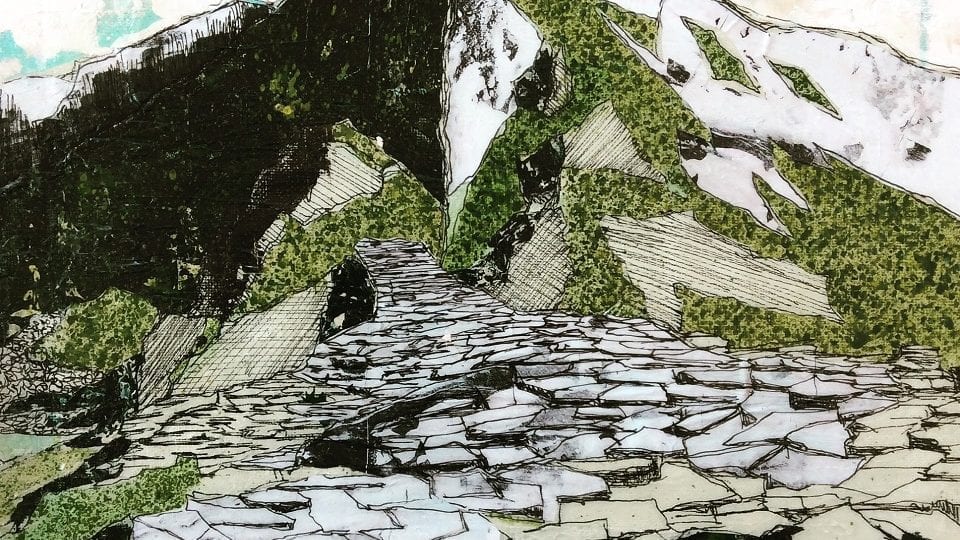Gary Plummer is an Irish artist currently based near the Rocky Mountains in Canada. His work is inspired by his love of the outdoors with a focus is on forms and colours that interest him to create mixed media and collage art. He has exhibited in galleries and been published internationally.
A: How do you think that your move from Ireland to Canada has affected the work that you produce in terms of environmental influence and cultural identity?
GP: The move here has definitely had a big influence, I like to get out and be active outside so the mountains have been a big inspiration for me. I’ve found there to be endless possibilities for creating new work here. The mountains are in a constant state of change season to season and even throughout the day, shadows that are cast in the morning are different to those that are cast in the evening. The snow and limestone rocky outcrops have a very abstract quality that I really like and they excite my sense of adventure. I’ve also found that being away from home encourages me to be nostalgic also and think about home, I like to create pieces of home to help me feel closer and its nice then to compare pictures of the west of Irelands landscapes with the Canadian rockies.
A: How does the intersection between photography and painting help you to develop your pieces? Why do you think it’s important to combine traditional and technological methods?
GP: I like to use my photos as a reference point, if I’m hiking I’ll take pictures of anything I feel could be used. I will go back over these at a later date and choose what I feel could work well. This gives me time to think about different ways I could approach potential pieces. I like playing with the idea about how painting and photography can both have their own place on the same canvas. I use photos as a reference to draw out loose forms. I then like the idea of abstract pieces to be used within these outlines. I started trying to manipulate the idea of painting by making some abstract pieces and taking photos of them and editing each photo, I then use these different images to cut up and use as collages in the piece. I will also apply paint straight to canvas where I feel its needed. I just like the idea of manipulating all these different elements, I find it quite exciting as if the possibilities are endless.
A: Do you think that painting is yet to develop in terms of contemporary art – do you think it’s important for there to be a sense that artists are still creating something new and innovative through paint?
GP: It’ll always be important that people are trying to add to what has been done in the past and explore different avenues. I think photography and digital media will continue to thrive and expand its own horizons whilst there will always be a drive for people to want to paint, there will always be innovative people that like to experiment and find new ways of creating something by their own hand. I kind of romanticise painting I suppose its whatever your into but with the arrival of photography as a new artform in the late 1800s people thought that painting as a way of expressing yourself was going to die out but yet here we are in 2017 and there’s extremely talented painters out there like Emily Smallwood, Conor Harrington and Mike Bernard to name a few I like of hand. Not working against photography or digital artforms but alongside it and with it.
A: What has been your favourite work to date?
GP: There’s a piece I made of the bow river valley in Canmore, near Banff that I really enjoyed working on, we had a great few days there and it was great to be able to make something to mark that.
A: And which has been the most difficult to produce?
GP: I made a piece based on the Plassey shipwreck in inisheer (the aran islands, Ireland). I walked along the shipwreck taking numerous up close photos and pieced them together, the resulting piece was a few metres long and quite time consuming
A: How do you think that the development of a piece differs from the original intentions? Are the origins important to you or is it about the final piece?
GP: I don’t think the origins of a piece matter after a certain point, for me I like to think about the final piece, if I over think about the origins I find it a bit too restrictive
A: What do you have planned for 2017?
GP: We are moving to Ireland later this year after the birth of our second son, I’m looking forward to future projects I have in mind at home, I’ve been developing a few ideas making more landscape pieces but using very different materials to what I’ve used in the past.
Credits:
1. Giants Causeway. Mixed media on canvas, 30.4cm x 40.6cm.




